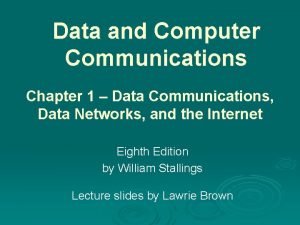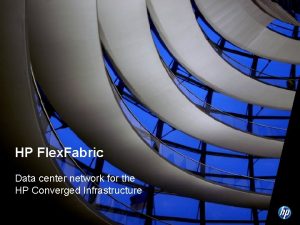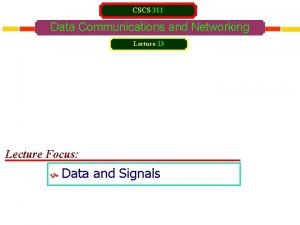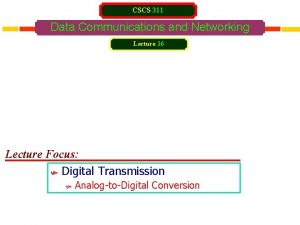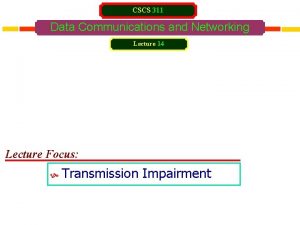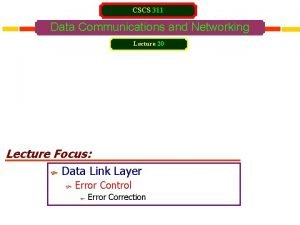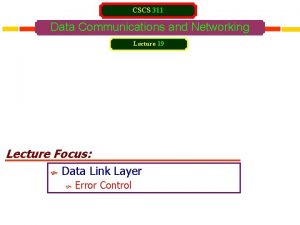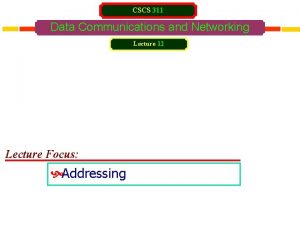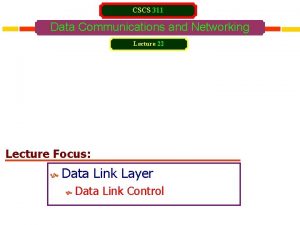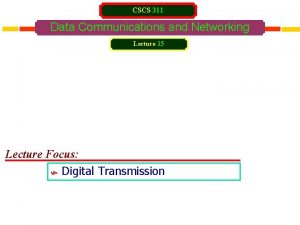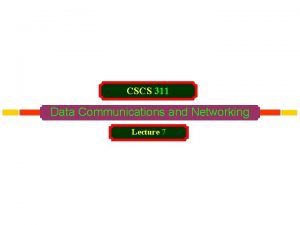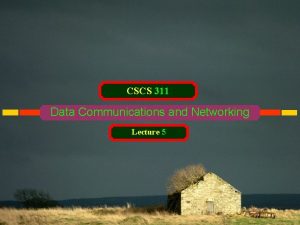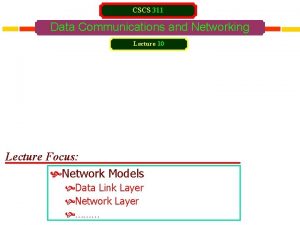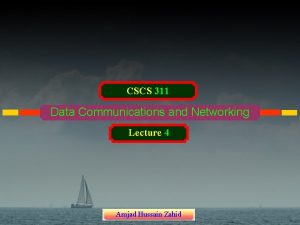CSCS 311 Data Communications and Networking Lecture 19















- Slides: 15

CSCS 311 Data Communications and Networking Lecture 19 Lecture Focus: Switching

Switching Background A network is a set of connected devices. Whenever we have multiple devices, we have the problem of how to connect them to make one-to-one communication possible. One solution is to make a point-to-point connection between each pair of devices (a mesh topology) or between a central device and every other device (a star topology). These methods, however, are impractical and wasteful when applied to very large networks. The number and length of the links require too much infrastructure to be cost-efficient, and the majority of those links would be idle most of the time. Other topologies employing multipoint connections, such as a bus, are ruled out because the distances between devices and the total number of devices increase beyond the capacities of the media and equipment.

Switching Background A better solution is switching. A switched network consists of a series of interlinked nodes, called switches. Switches are devices capable of creating temporary connections between two or more devices linked to the switch. In a switched network, some of these nodes are connected to the end systems (computers or telephones, for example). Others are used only for routing. Figure below shows a switched network. The end systems (communicating devices) are labeled A, B, C, D, and so on. The switches are labeled I, III, IV, and V. Each switch is connected to multiple links.

Switching Background Switched network

Switching Techniques Many methods Three methods of switching have been important: Circuit switching Packet switching Message switching The first two are commonly used today. The third has been phased out in general communications but still has networking applications.

Switching Techniques We can divide today's networks into three broad categories: Circuit-switched networks Packet-switched networks Message-switched. Packet-switched networks can further be divided into two subcategories: Virtual-circuit networks Datagram networks

Switching Techniques

Switching Techniques CIRCUIT-SWITCHED NETWORKS A circuit-switched network consists of a set of switches connected by physical links. A connection between two stations is a dedicated path made of one or more links. However, each connection uses only one dedicated channel on each link. Each link is normally divided into n channels by using FDM or TDM. A circuit-switched network is made of a set of switches connected by physical links, in which each link is divided into n channels.

Switching Techniques CIRCUIT-SWITCHED NETWORKS A trivial circuit-switched network with 4 switches and 4 links. Each link is divided into n (n is 3 in the figure) channels by using FDM or TDM. The multiplexing symbols have explicitly been shown to emphasize the division of the link into channels even though multiplexing can be implicitly included in the

Switching Techniques CIRCUIT-SWITCHED NETWORKS The end systems, such as computers or telephones, are directly connected to a switch. In figure, only two end systems have been shown for simplicity. When end system A needs to communicate with end system M, system A needs to request a connection to M that must be accepted by all switches as well as by M itself. This is called the setup phase; a circuit (channel) is reserved on each link, and the combination of circuits or channels defines the dedicated path. After the dedicated path made of connected circuits (channels) is established, data transfer can take place. After all data have been transferred, the circuits are torn down.

Switching Techniques CIRCUIT-SWITCHED NETWORKS Circuit switching takes place at the physical layer. Before starting communication, the stations must make a reservation for the resources to be used during the communication. These resources, such as channels (bandwidth in FDM and time slots in TDM), switch buffers, switch processing time, and switch input/output ports, must remain dedicated during the entire duration of data transfer until the teardown phase. Data transferred between the two stations are not packetized (physical layer transfer of the signal). The data are a continuous flow sent by the source station and received by the destination station, although there may be periods of silence. There is no addressing involved during data transfer. The switches route the data based on their occupied band (FDM) or time slot (TDM). Of course, there is end-to-end addressing used during the setup phase.

Switching Techniques CIRCUIT-SWITCHED NETWORKS Example: Let us have a circuit-switched network to connect eight telephones in a small area. Communication is through 4 -k. Hz voice channels. We assume that each link uses FDM to connect a maximum of two voice channels. The bandwidth of each link is then 8 -k. Hz. Figure below shows the situation. Telephone 1 is connected to telephone 7; 2 to 5; 3 to 8; & 4 to 6. Of course, the situation may change when new connections are made. The switch controls the connections.

Switching Techniques CIRCUIT-SWITCHED NETWORKS

Switching Techniques CIRCUIT-SWITCHED NETWORKS Example: Consider a circuit-switched network that connects computers in two remote offices of a private company. There are two 4 X 8 (4 inputs and 8 outputs) switches in this network. For each switch, four output ports are folded into the input ports to allow communication between computers in the same office. Four other output ports allow communication between the two offices. Figure below shows the situation.

Switching Techniques CIRCUIT-SWITCHED NETWORKS
 Cscs
Cscs Backbone network components
Backbone network components Business data communications and networking
Business data communications and networking Introduction to data communications and networking
Introduction to data communications and networking Business data communications and networking
Business data communications and networking Three dumb routers
Three dumb routers Crisis communication lecture
Crisis communication lecture 01:640:244 lecture notes - lecture 15: plat, idah, farad
01:640:244 lecture notes - lecture 15: plat, idah, farad Computer network assignment
Computer network assignment Telecommunications and data communications
Telecommunications and data communications Data and computer communications 10th edition
Data and computer communications 10th edition Data and computer communication
Data and computer communication Data and computer communications
Data and computer communications Simplified data communication model
Simplified data communication model Jellyfish networking data centers randomly
Jellyfish networking data centers randomly Flex data center
Flex data center












